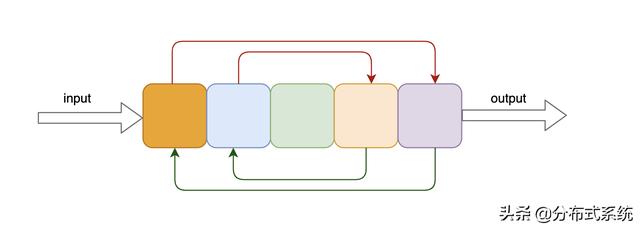Golangд№ӢжөҒејҸзј–зЁӢ( дәҢ )
FilterFilterеҮҪж•°жҸҗдҫӣиҝҮж»Өitemзҡ„еҠҹиғҪ пјҢ FilterFuncе®ҡд№үиҝҮж»ӨйҖ»иҫ‘trueдҝқз•ҷitem пјҢ falseеҲҷдёҚдҝқз•ҷ:
// дҫӢеӯҗ дҝқз•ҷеҒ¶ж•°s := []int{1, 2, 3, 4, 5, 6, 7, 8, 9, 0}fx.From(func(source chan<- interface{}) {for _, v := range s {source <- v}}).Filter(func(item interface{}) bool {if item.(int)%2 == 0 {return true}return false})// жәҗз Ғfunc (p Stream) Filter(fn FilterFunc, opts ...Option) Stream { return p.Walk(func(item interface{}, pipe chan<- interface{}) {// жү§иЎҢиҝҮж»ӨеҮҪж•°trueдҝқз•ҷ пјҢ falseдёўејғif fn(item) {pipe <- item} }, opts...)}GroupGroupеҜ№жөҒж•°жҚ®иҝӣиЎҢеҲҶз»„ пјҢ йңҖе®ҡд№үеҲҶз»„зҡ„key пјҢ ж•°жҚ®еҲҶз»„еҗҺд»Ҙsliceеӯҳе…Ҙchannel:
// дҫӢеӯҗ жҢүз…§йҰ–еӯ—з¬Ұ"g"жҲ–иҖ…"p"еҲҶз»„ пјҢ жІЎжңүеҲҷеҲҶеҲ°еҸҰдёҖз»„ss := []string{"golang", "google", "php", "python", "java", "c++"}fx.From(func(source chan<- interface{}) {for _, s := range ss {source <- s} }).Group(func(item interface{}) interface{} {if strings.HasPrefix(item.(string), "g") {return "g"} else if strings.HasPrefix(item.(string), "p") {return "p"}return "" }).ForEach(func(item interface{}) {fmt.Println(item) })}// жәҗз Ғfunc (p Stream) Group(fn KeyFunc) Stream {// е®ҡд№үеҲҶз»„еӯҳеӮЁmap groups := make(map[interface{}][]interface{}) for item := range p.source {// з”ЁжҲ·иҮӘе®ҡд№үеҲҶз»„keykey := fn(item)// keyзӣёеҗҢеҲҶеҲ°дёҖз»„groups[key] = append(groups[key], item) } source := make(chan interface{}) go func() {for _, group := range groups {// зӣёеҗҢkeyзҡ„дёҖз»„ж•°жҚ®еҶҷе…ҘеҲ°channelsource <- group}close(source) }() return Range(source)}ReversereverseеҸҜд»ҘеҜ№жөҒдёӯе…ғзҙ иҝӣиЎҢеҸҚиҪ¬еӨ„зҗҶ:
 ж–Үз« жҸ’еӣҫ
ж–Үз« жҸ’еӣҫ
// дҫӢеӯҗfx.Just(1, 2, 3, 4, 5).Reverse().ForEach(func(item interface{}) {fmt.Println(item)})// жәҗз Ғfunc (p Stream) Reverse() Stream { var items []interface{}// иҺ·еҸ–жөҒдёӯж•°жҚ® for item := range p.source {items = append(items, item) } // еҸҚиҪ¬з®—жі• for i := len(items)/2 - 1; i >= 0; i-- {opp := len(items) - 1 - iitems[i], items[opp] = items[opp], items[i] }// еҶҷе…ҘжөҒ return Just(items...)}DistinctdistinctеҜ№жөҒдёӯе…ғзҙ иҝӣиЎҢеҺ»йҮҚ пјҢ еҺ»йҮҚеңЁдёҡеҠЎејҖеҸ‘дёӯжҜ”иҫғеёёз”Ё пјҢ з»ҸеёёйңҖиҰҒеҜ№з”ЁжҲ·idзӯүеҒҡеҺ»йҮҚж“ҚдҪң:
// дҫӢеӯҗfx.Just(1, 2, 2, 2, 3, 3, 4, 5, 6).Distinct(func(item interface{}) interface{} {return item}).ForEach(func(item interface{}) {fmt.Println(item)})// з»“жһңдёә 1 пјҢ 2 пјҢ 3 пјҢ 4 пјҢ 5 пјҢ 6// жәҗз Ғfunc (p Stream) Distinct(fn KeyFunc) Stream { source := make(chan interface{}) threading.GoSafe(func() {defer close(source)// йҖҡиҝҮkeyиҝӣиЎҢеҺ»йҮҚ пјҢ зӣёеҗҢkeyеҸӘдҝқз•ҷдёҖдёӘkeys := make(map[interface{}]lang.PlaceholderType)for item := range p.source {key := fn(item)// keyеӯҳеңЁеҲҷдёҚдҝқз•ҷif _, ok := keys[key]; !ok {source <- itemkeys[key] = lang.Placeholder}} }) return Range(source)}WalkWalkеҮҪ数并еҸ‘зҡ„дҪңз”ЁеңЁжөҒдёӯжҜҸдёҖдёӘitemдёҠ пјҢ еҸҜд»ҘйҖҡиҝҮWithWorkersи®ҫзҪ®е№¶еҸ‘ж•° пјҢ й»ҳи®Ө并еҸ‘ж•°дёә16 пјҢ жңҖе°Ҹ并еҸ‘ж•°дёә1 пјҢ еҰӮи®ҫзҪ®unlimitedWorkersдёәtrueеҲҷ并еҸ‘ж•°ж— йҷҗеҲ¶ пјҢ дҪҶ并еҸ‘еҶҷе…ҘжөҒдёӯзҡ„ж•°жҚ®з”ұdefaultWorkersйҷҗеҲ¶ пјҢ WalkFuncдёӯз”ЁжҲ·еҸҜд»ҘиҮӘе®ҡд№үеҗҺз»ӯеҶҷе…ҘжөҒдёӯзҡ„е…ғзҙ пјҢ еҸҜд»ҘдёҚеҶҷе…Ҙд№ҹеҸҜд»ҘеҶҷе…ҘеӨҡдёӘе…ғзҙ :
// дҫӢеӯҗfx.Just("aaa", "bbb", "ccc").Walk(func(item interface{}, pipe chan<- interface{}) {newItem := strings.ToUpper(item.(string))pipe
жҺЁиҚҗйҳ…иҜ»
- жңәеҷЁдәә|дёҮе·һеҢәдёҫеҠһвҖңдёӯеӣҪжўҰ科жҠҖжўҰвҖқжңәеҷЁдәәзј–зЁӢеӨ§иөӣ
- иӢұзү№е°”жҺЁеҮәеҸҜжЈҖжөӢд»Јз Ғй”ҷиҜҜзҡ„ControlFlagжңәеҷЁзј–зЁӢе·Ҙе…·
- еҸҜзј–зЁӢ3Dжү“еҚ°иҖ—жқҗеҸҜеё®еҠ©жҷ®йҖҡ3Dжү“еҚ°жңәиҪ»жқҫе®һзҺ°еӨҡжқҗж–ҷзү©е“Ғзҡ„еҲ¶дҪң
- иҸңйёҹеӯҰзј–зЁӢпјҢдёҚжҮӮC++ thisжҢҮй’ҲпјҹиҝҳдёҚиө¶еҝ«жқҘеӯҰдёҖеӯҰ
- еӨ§еӯҰз”ҹеҰӮдҪ•жҸҗеҚҮJavaзј–зЁӢиғҪеҠӣ
- еҜ№дәҺдёҖдёӘзј–зЁӢе°ҸзҷҪжқҘиҜҙпјҢиҜҘеӯҰд№ JavaиҝҳжҳҜPython
- зӣҳзӮ№пјҡ2020е№ҙ5з§ҚжөҒиЎҢзҡ„ AI зј–зЁӢиҜӯиЁҖпјҢе°ұдёҡй«ҳи–ӘдёҚжҳҜжўҰ
- дёәдҪ•еӯҰд№ зј–зЁӢеҫҖеҫҖйғҪжҳҜд»Һзј–еҶҷиҫ“еҮәHelloWorldзҡ„зЁӢеәҸејҖе§Ӣ
- жҲ‘жөӢпҪңдёҖж¬ҫйҮҚйҮҸд»…87е…Ӣзҡ„ж— дәәжңәпјҢеҰӮдҪ•й“ҫжҺҘеӨ§з–Ҷж•ҷиӮІ7е№ҙзј–зЁӢжўҰ
- Golang еҲҮзүҮз»јеҗҲжҢҮеҚ—

















